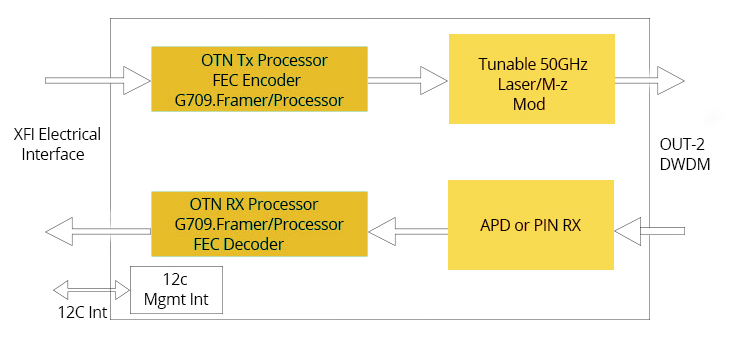

Sort by :Price: Low to High
Categories
{{cate.name}}
view {{page_size}}
What is 10G DWDM Tunable SFP+ and how does it work
The 10G DWDM Tunable is a unique optical module that allows you to select the channel or "color" of the laser emission. Simply put, most DWDM systems typically use optical modules with a fixed wavelength, but Tunable optical modules have the ability to adjust the wavelength of the optical module at any time to meet the needs of different applications. It should be noted that the wavelength adjustment function of Tunable SFP+ DWDM is only used in DWDM systems.
The tunable SFP+ DWDM transceiver integrates the receiver and transmits the path on one module. On the transmit side, the 10Gbps serial data stream is recovered, retimed, and passed to a modulator driver. The modulator driver biases and modulates a C-band-tunable integrated laser Mach-Zehnder (ILMZ), enabling data transmission over single-mode fiber through an industry-standard LC connector. On the receiver side, the 10Gbps data stream is recovered from an APD/ trans-impedance amplifier, retimed, and passed to an output driver. This tunable SFP+ module features a duplex industry-standard LC connector.
There are two kinds of 10G DWDM tunable modules in the market today:
The tunable XFP optical modules consist of an integrated full C-band tunable transmitter and a high-performance receiver, with wavelengths that can be set to default values in the 50GH DWDM ITU grid, and a maximum distance of 80km on single-mode fiber.
The tunable SFP+ DWDM series optical transceiver is a high performance and cost-effective SFP+ transceiver module designed for 10G SDH/SONET, 10G Ethernet DWDM fiber optic transmission applications, designed to support the full range of C-band ITU-T wavelengths data rates up to 11.3Gbs and distances up to 40km/80km. In the market, different manufacturers may name the tunable SFP+ optical module in different forms. For example, Cisco’s “DWDM-SFP10G-C” is equivalent to Fiber Mall’s “SFP-DW10GTU-80C”.
The advantages of the 10G DWDM Tunable module

Tunable optical modules have developed rapidly in recent years. They have become popular in DWDM transmission systems because of their various capabilities. Especially when combined with reconfigurable optical add-drop multiplexer (ROADM), the 10G DWDM tunable optical modules can become a powerful transmission component. In short, the tunable SFP+ DWDM module has the following advantages.
(1) Wide adjustment range. Compared with the common fixed wavelength optical module, DWDM dimmable module can save a lot of time and money.
(2) By reducing the linewidth, it is more suitable for a 100G system. The ability to adjust the wavelength provides more convenience to meet different transmission requirements.
(3) Adjustable lasers can switch wavelengths in nanoseconds. Adjustable laser is an important part of the tunable optical module. It is a high-speed and high-performance optical device so that the required wavelength can be reprogrammed in a few seconds.
To sum up, the benefits of 10G DWDM tunable modules are:
· wide adjustment range
· compatible with 100G system
· Better spare parts management
· software adjustable wavelength
· long term cost-effective
Working principle, application and cost are the main differences between the tunable SFP+ DWDM and fixed-wavelength DWDM SFP+ transceivers.
Firstly, in terms of the working principle, each fixed-wavelength DWDM module is designed with a specific wavelength, so the module can only be deployed in the network node that requires the corresponding wavelength. But with the tunable SFP+ DWDM fiber module, users can use the module to connect any ports of the same DWDM MUX through fiber cables since the wavelength of the tunable transceiver can be tuned to adapt to the different port wavelengths.

Secondly, in terms of the application, with different working principles, the standard 10G DWDM SFP+ modules are traditionally deployed in networks that require little channel change or addition. While the 10G tunable SFP+ DWDM transceivers are envisioned to serve as spare units to suit the networks that need to change the wavelength as businesses grow.
Thirdly, in terms of the cost, it's true that the cost of an individual fixed-wavelength transceiver is lower than a tunable SFP+ DWDM module. But in the long run, tunable optics will reduce OPEX. In this case, tunable optics help reduce the demand for DWDM SFP+ transceiver inventory, which will reduce the cost and maximize network flexibility.
The 10G DWDM tunable module provides similar functions to the traditional fixed-wavelength DWDM optical module. These optical modules are designed to operate at user-defined wavelengths. The upfront cost of the tunable SFP+ DWDM modules is high, but for high-density large DWDM networks using dozens of fixed-length optical modules, a single tunable module can do better under similar conditions.